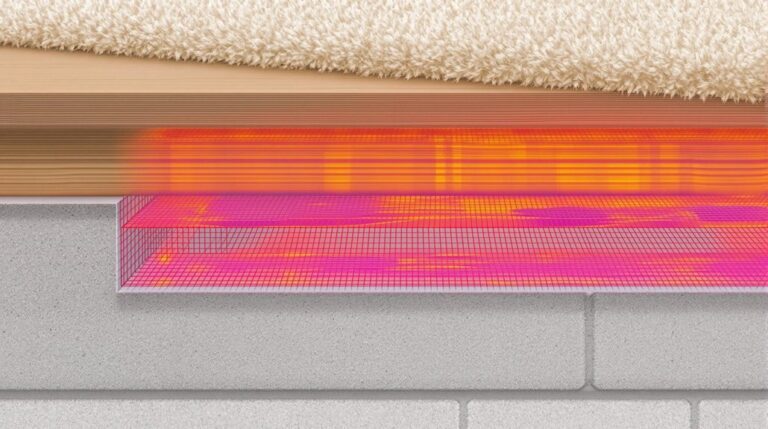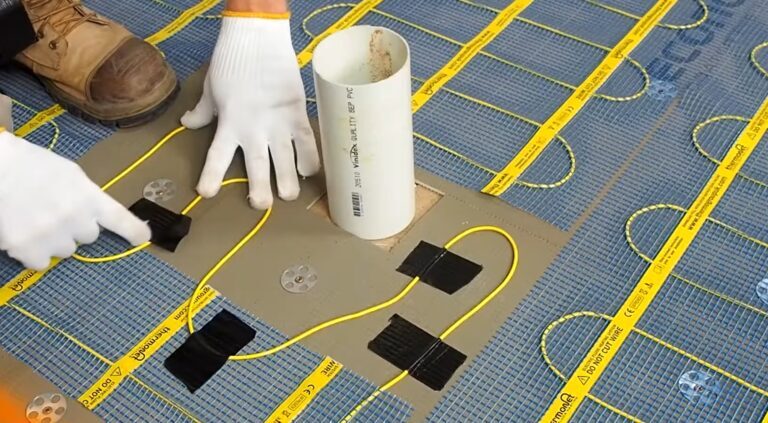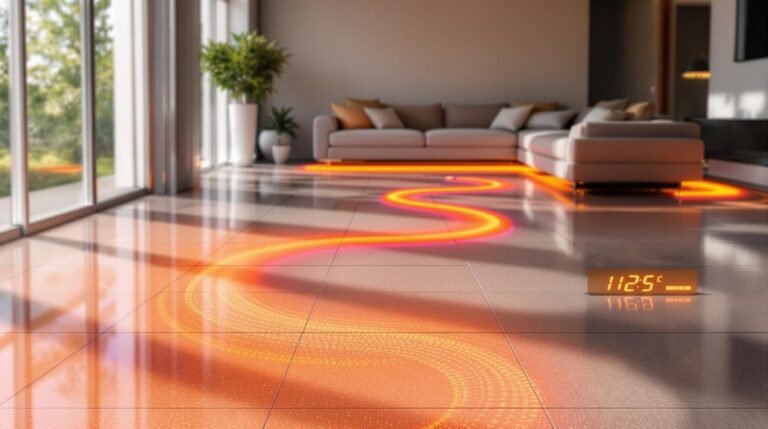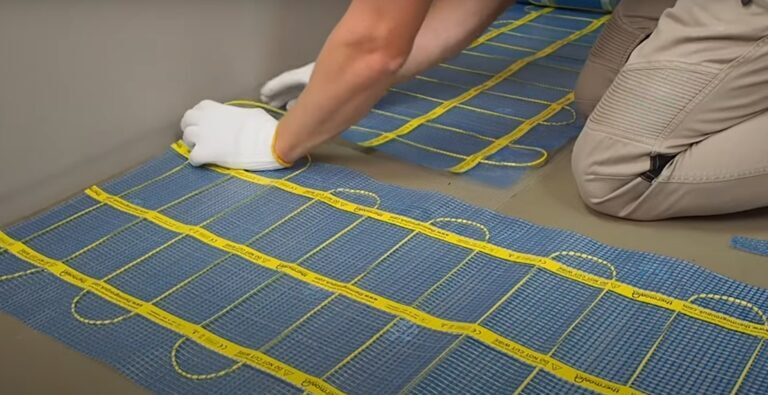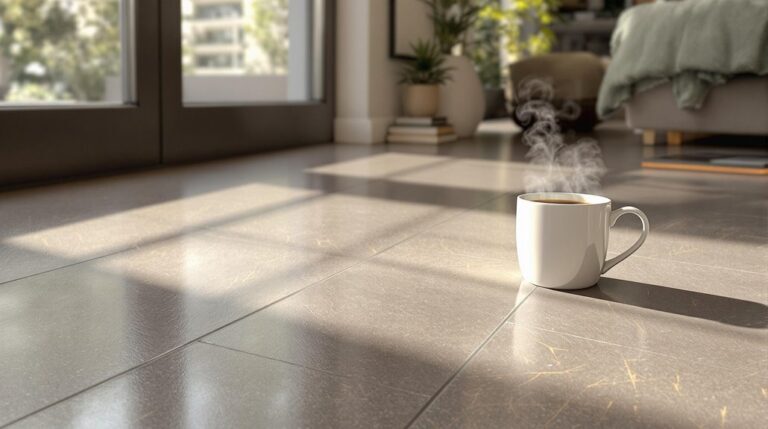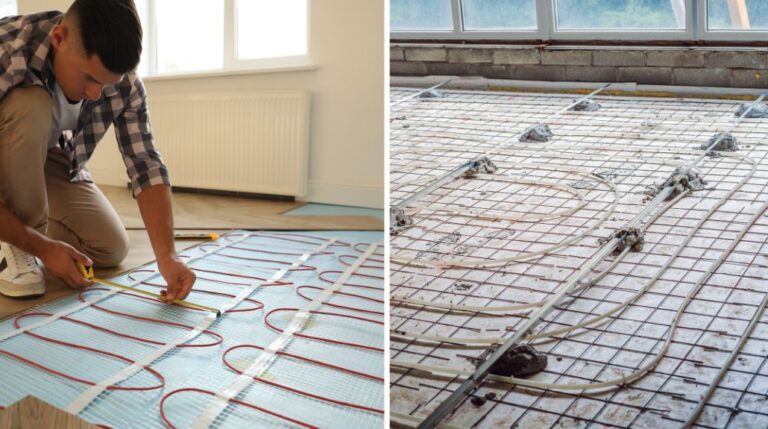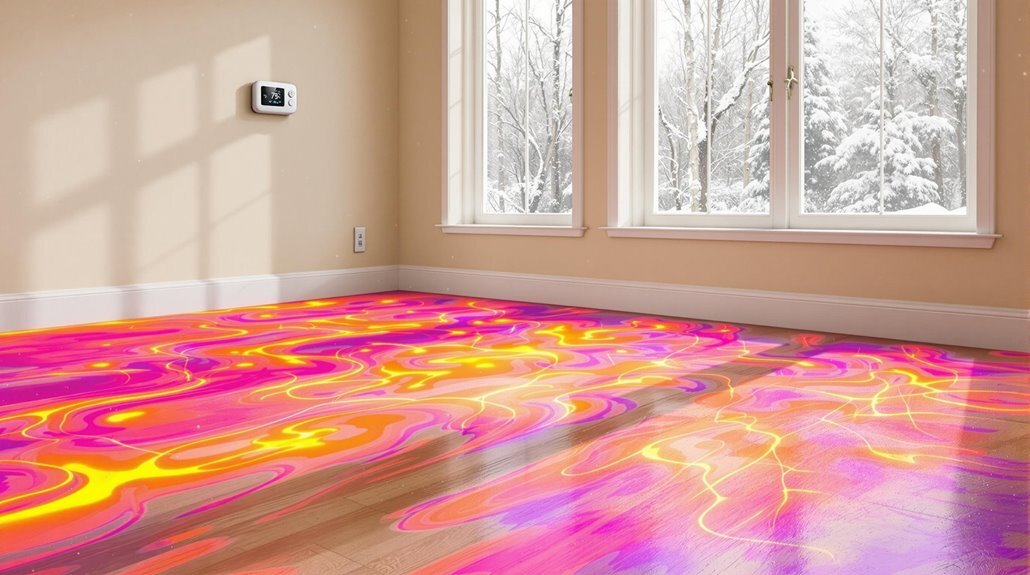
Did you know that homeowners can save up to 40% on their heating costs by switching to underfloor heating systems? When you’re considering a heating upgrade, the initial sticker shock of installation might make you hesitate. However, the long-term operational costs tell a different story, especially with hydronic systems that can run for as little as $184 annually for a standard living area. Before you dismiss the idea of warm floors as a luxury you can’t afford, you’ll want to understand how these systems could actually reduce your monthly energy bills.
Key Takeaways
- Underfloor heating systems use 15-40% less energy than traditional radiators, making them cost-effective for long-term operation.
- Monthly operating costs average around $23.60 for a 10m² system, which is lower than many traditional heating methods.
- Hydronic systems have higher installation costs but lower running costs ($184-$552 annually) compared to electric systems ($623-$1,869 annually).
- Proper insulation can reduce heat loss by up to 50% and improve efficiency by 20-30%, significantly lowering operational costs.
- Smart thermostats and continuous low-temperature operation optimize performance and minimize energy consumption for cost-effective heating.
Understanding Underfloor Heating Costs: Installation and Running Cost Breakdown
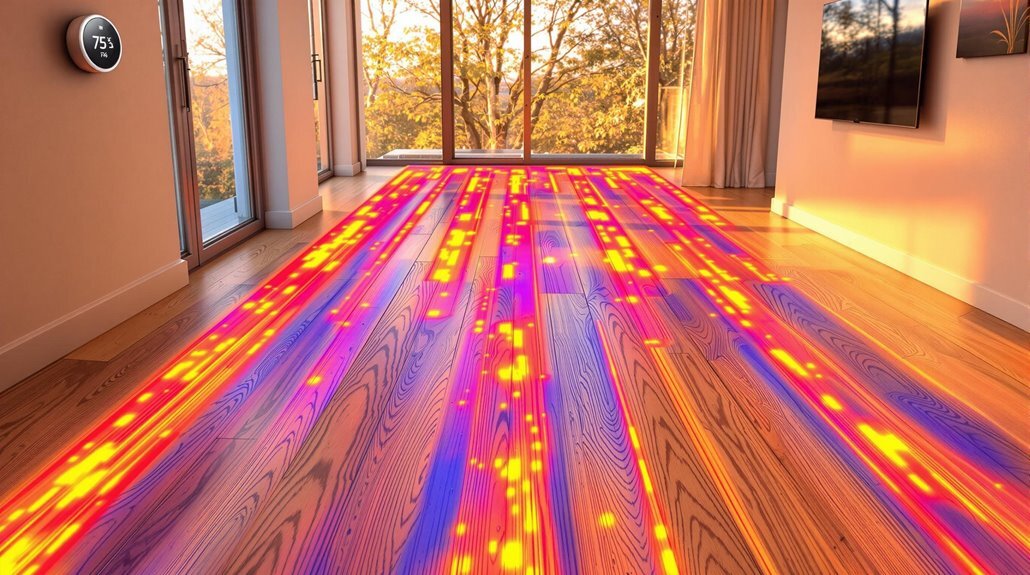
Every homeowner pondering underfloor heating asks the same question: is it worth the investment? As a specialist in underfloor heating systems across Sydney, I can tell you that the answer depends on several key factors, including your home size, choice of system, and energy source.
Let’s break down the costs. For electric underfloor heating, you’re looking at $19,000 to $36,000 for a whole-home installation, while hydronic systems range from $14,000 to $48,000. While these initial installation costs might seem steep, it’s important to take into account the long-term running costs of each system.
Electric underfloor heating typically costs more to operate, with annual running costs between $623 and $1,869 for rooms ranging from 10m² to 30m². Hydronic systems, on the other hand, are more economical to run, with yearly costs from $184 to $552 for similar spaces. Your choice of energy source plays a vital role here – electricity generally costs more than gas for heating purposes.
The good news is you can markedly reduce running costs through proper insulation. We’ve seen customers cut their heating expenses by ensuring their homes are well-insulated before installation. Additionally, if you’re building a new home, you’ll save on installation costs compared to retrofitting an existing property.
Your home size directly impacts both installation and running costs. Larger homes require more extensive systems and materials, but they can benefit from economies of scale in installation.
We recommend reflecting on your specific needs and long-term plans when choosing between electric and hydronic systems.
Energy Efficiency and Power Usage: Underfloor Heating Running Costs Explained
When discussing underfloor heating costs, we can’t overlook the remarkable energy efficiency these systems offer. Our experience at Floor Heating Today shows that underfloor heating systems use 15-40% less energy than traditional radiators, considerably impacting your running costs over time.
The power usage of your system depends on several key factors. Your floor size and insulation quality play essential roles, with typical systems using 100-150 watts per square meter. For example, if you’re heating a 12m² room, you’ll use approximately 0.9 kW per hour. However, the insulation impact can dramatically reduce these figures – proper insulation can cut downward heat loss by up to 50%.
You’ll benefit from the radiant heat advantage these systems provide. Unlike forced air systems that waste energy heating the ceiling first, underfloor heating warms objects and people directly. This means you can maintain comfort at lower temperatures, further reducing your energy consumption. The efficiency statistics speak for themselves – you’re getting more warmth while using less power.
To maximize your system’s energy efficiency, we recommend installing programmable thermostats. These allow you to control temperatures precisely and reduce consumption during off-peak hours.
When combined with quality insulation boards and proper installation, you’ll achieve peak performance. While the initial underfloor heating cost might be higher than traditional systems, the long-term running costs often prove more economical, especially when you consider the even heat distribution and reduced energy waste.
Types of Underfloor Heating Systems: Electric vs. Hydronic Floor Heating
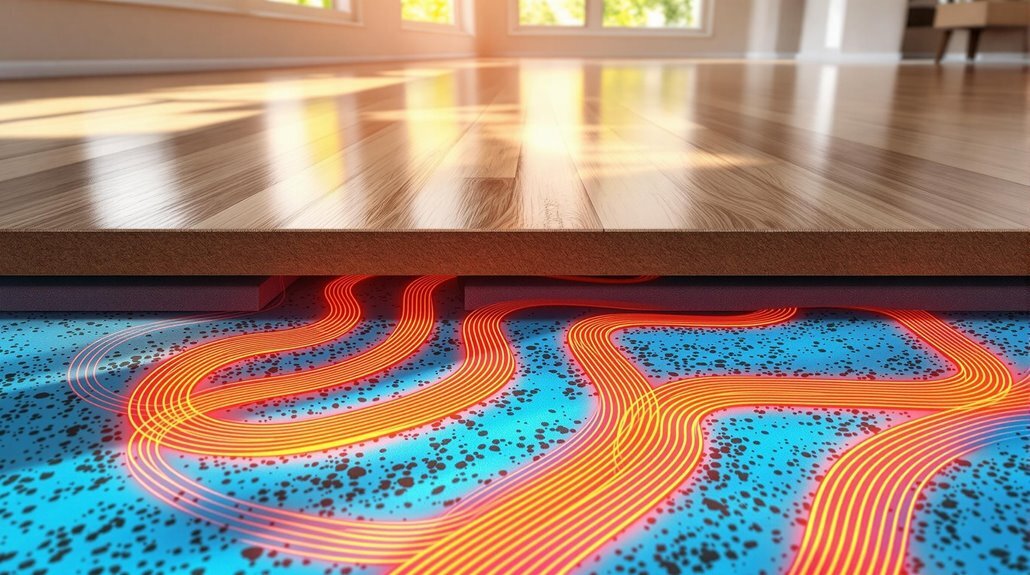
At Floor Heating Today, we work with two primary types of underfloor heating systems: hydronic and electric. Each system offers distinct advantages and considerations when it comes to running costs and installation.
Hydronic underfloor heating uses a network of pipes that circulate warm water beneath your floor. While you’ll face higher installation costs (typically between $80-$150 per square meter), you’ll benefit from lower running costs in the long term.
This system’s efficiency comes from its ability to use various energy sources, including natural gas, propane, or even solar thermal power. However, you’ll need to factor in regular maintenance and longer heat-up times.
Electric underfloor heating, on the other hand, utilizes heating mats or thin wires powered by mains electricity. You’ll find it’s cheaper to install and requires minimal maintenance, making it an attractive option for smaller spaces or retrofitting projects.
The system heats up quickly and offers precise temperature control through thermostats. However, the cost to run electric systems tends to be higher due to electricity prices.
When choosing between the two, consider your specific needs. If you’re building a new home or heating large areas, hydronic systems offer better long-term value despite higher upfront costs.
For smaller spaces or renovation projects, electric systems provide a more practical solution with their easier installation and lower initial investment.
Both systems require proper insulation to maintain efficiency, so factor this into your planning to optimize running costs and performance.
Installation and Operating Expenses: How Much Does Underfloor Heating Cost to Run?
Understanding the true cost of underfloor heating means looking at both installation and day-to-day expenses. At Floor Heating Today, we’ve found that while underfloor heating installation is relatively low-cost compared to traditional systems, the total investment depends on your chosen system type.
Operational costs for a 10m² system average around $23.60 per month, though this varies based on usage patterns and floor insulation quality.
Here are three key factors that influence your ongoing expenses:
- Floor insulation can reduce your running costs by up to 50%, making it a vital investment during installation.
- Running your system continuously at lower temperatures is more efficient than frequent short bursts at high temperatures.
- You can operate underfloor heating at 6-8 degrees lower than traditional heating systems while maintaining the same comfort level.
The comparative costs between different heating methods clearly favor underfloor systems in the long run.
Your efficiency and cost factors will largely depend on proper installation, insulation quality, and smart usage patterns. By implementing these considerations, you’ll maximize your system’s efficiency while minimizing operational expenses.
Insulation and Temperature Control: Reducing Underfloor Heating Running Costs
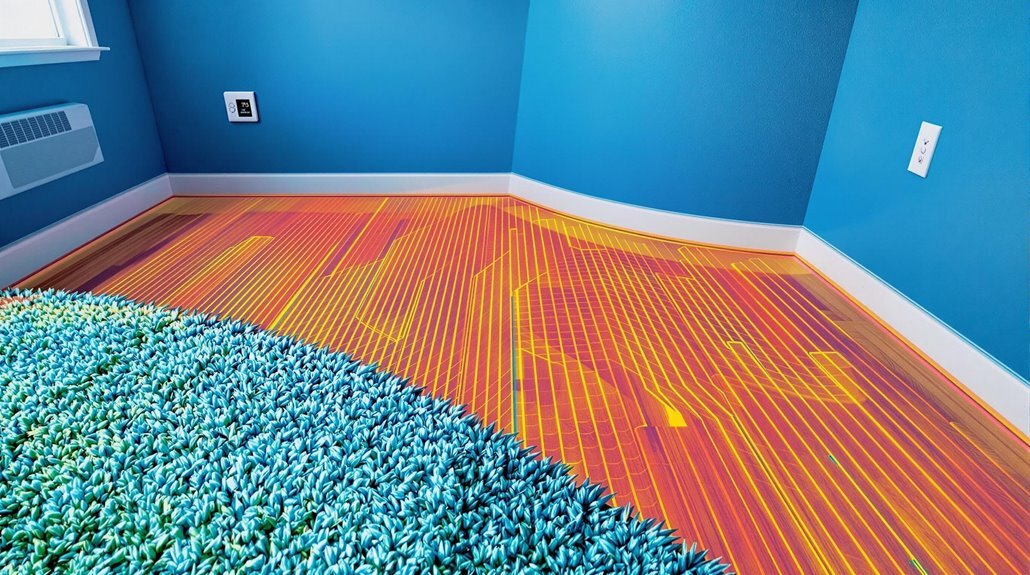
Proper insulation and temperature control make all the difference in your underfloor heating system’s performance. At Floor Heating Today, we’ve seen how quality insulation can enhance efficiency by 20-30% while reducing heat loss by up to 50%. This significant improvement directly impacts your running costs and comfort levels.
Installing insulation boards beneath your underfloor heating system creates a thermal barrier that prevents heat from escaping downward. You’ll notice faster heating times and more consistent temperatures throughout your space. The insulation boards also help minimize noise transmission between floors, which is particularly beneficial in multi-story homes.
Temperature control is equally important for optimizing your system’s performance. By installing a programmable thermostat, you’ll have precise control over your heating schedule and temperature settings. Since underfloor heating operates effectively at lower temperatures than traditional radiators, you’ll see substantial energy savings. Your system can maintain comfortable temperatures while using 15-40% less energy than conventional heating methods.
The combination of proper insulation and smart temperature control creates an efficient heating solution that’s cost-effective to run. You won’t need to wait long for your living areas to warm up, and you’ll enjoy even heat distribution without hot or cold spots.
The polystyrene insulation boards we recommend are lightweight yet durable, offering excellent thermal properties that maximize your system’s efficiency. When you consider the long-term energy savings and improved comfort levels, investing in quality insulation and temperature control measures proves to be a wise financial decision.
Cost Comparison With Traditional Heating: Is Underfloor Heating a Cost-Effective Option?
Many homeowners ask us about the true cost differences between underfloor heating and traditional heating systems. While it’s true that the initial installation costs of underfloor heating are higher, ranging from $19,000 to $48,000 depending on the system type, the running costs tell a different story.
At Floor Heating Today, we’ve found that both electric underfloor heating and hydronic systems consistently deliver lower running costs compared to traditional heating systems.
Here’s why underfloor heating is more cost-effective in the long run:
- Energy efficiency: Underfloor heating distributes warmth evenly throughout your space, requiring lower temperatures to achieve the same comfort level as traditional systems, resulting in reduced energy consumption.
- Heat retention: Hydronic systems, in particular, excel at retaining heat for extended periods, which means less energy is needed to maintain your desired temperature compared to traditional radiators that constantly cycle on and off.
- Smart control options: Through proper thermostat programming, you can optimize your system’s performance and further reduce running costs by heating only the rooms you need, when you need them.
While the upfront underfloor heating cost might seem substantial, our Sydney customers regularly report significant savings on their energy bills after switching from traditional heating systems.
The key to maximizing these savings lies in proper installation, adequate insulation, and intelligent system management. When you consider the long-term benefits, underfloor heating proves to be a smart investment for your home.
Install Underfloor Heating With Professionals: Get an Underfloor Heating Quote
Underfloor heating is an energy-efficient heating option that enhances comfort while reducing long-term costs. With electric floor heating, you can enjoy even warmth without bulky radiators, making it perfect for homes with tile flooring. Many homeowners ask, how much does underfloor heating cost? While the upfront investment varies, the cost of running an electric system is often lower than traditional heating. To maximize efficiency and minimize expenses, it’s crucial to run underfloor heating with the right insulation and smart controls.
Ready to upgrade your home? Contact Floor Heating Today for expert installation and a cost-effective heating solution!


